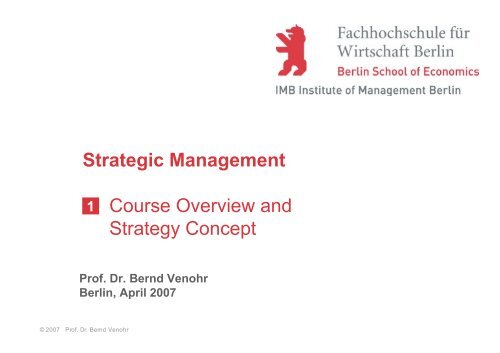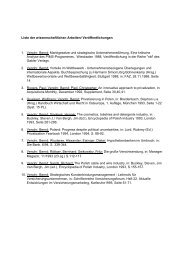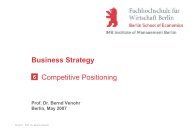Strategic Management Course Overview and Strategy Concept
Strategic Management Course Overview and Strategy Concept
Strategic Management Course Overview and Strategy Concept
You also want an ePaper? Increase the reach of your titles
YUMPU automatically turns print PDFs into web optimized ePapers that Google loves.
<strong>Strategic</strong> <strong>Management</strong><br />
1<br />
© 2007 Prof. Dr. Bernd Venohr<br />
<strong>Course</strong> <strong>Overview</strong> <strong>and</strong><br />
<strong>Strategy</strong> <strong>Concept</strong><br />
Prof. Dr. Bernd Venohr<br />
Berlin, April 2007
Agenda<br />
Introduction to <strong>Strategy</strong><br />
1<br />
2<br />
3<br />
Business <strong>Strategy</strong><br />
4<br />
5<br />
6<br />
© 2007 Prof. Dr. Bernd Venohr<br />
<strong>Course</strong> <strong>Overview</strong> <strong>and</strong> <strong>Strategy</strong> <strong>Concept</strong><br />
Economics of <strong>Strategy</strong><br />
Shareholder Value<br />
External Environment<br />
Internal Environment<br />
Competitive Positioning<br />
Corporate <strong>Strategy</strong><br />
7<br />
8<br />
9<br />
<strong>Strategy</strong> Process<br />
10<br />
11<br />
Diversification<br />
Mergers & Acquisitions<br />
Global <strong>Strategy</strong><br />
Organizational Structure <strong>and</strong> Control<br />
<strong>Strategic</strong> Leadership<br />
2
Agenda<br />
Introduction to <strong>Strategy</strong><br />
1<br />
© 2007 Prof. Dr. Bernd Venohr<br />
<strong>Course</strong> <strong>Overview</strong> <strong>and</strong> <strong>Strategy</strong> <strong>Concept</strong><br />
- <strong>Course</strong> overview<br />
- Definition of strategy <strong>and</strong> history of strategy concept<br />
- Assignment of “case study” companies<br />
- Next session<br />
3
Learning Objectives<br />
� Underst<strong>and</strong> course objectives <strong>and</strong> design<br />
– What is expected from you?<br />
– How will we work together?<br />
– How you will be graded?<br />
� Introduction strategy concept<br />
– Key definitions<br />
– Framework of <strong>Course</strong><br />
© 2007 Prof. Dr. Bernd Venohr<br />
4
Current Events<br />
� Why are Volkswagen <strong>and</strong> DaimlerChrysler in trouble, whereas BMW <strong>and</strong><br />
Toyota are successful?<br />
� What is the rationale of Bayer AG buying Schering AG?<br />
� Why has BenQ not been able to turn-around the mobile phone division of<br />
Siemens ?<br />
© 2007 Prof. Dr. Bernd Venohr<br />
5
Returns on Invested Capital vary widely by Industry<br />
Pharmaceuticals, biotechnology<br />
Household, personal products<br />
© 2007 Prof. Dr. Bernd Venohr<br />
Software, services<br />
Media<br />
Commercial services, supplies<br />
Semiconductors, semiconductor equipment<br />
Health care equipment, services<br />
Food, beverage, tobacco<br />
Consumer services<br />
Technology hardware, equipment<br />
Automobiles, components<br />
Capital goods<br />
Consumer durables, apparel<br />
Food, staples retailing<br />
Retailing<br />
Materials<br />
Energy<br />
Transportation<br />
Telecommunication services<br />
Utilities<br />
Median annual ROIC (%)*<br />
1963-2004<br />
1995-2004<br />
Total sample<br />
75th percentile<br />
Median<br />
25th percentile<br />
0 5 10 15 20 25 30<br />
1963-2004<br />
Source: A long-term look at ROIC , Bin Jiang <strong>and</strong> Timothy M. Koller, McKQuartely 2006 Number 1; *ROIC excl. 6<br />
goodw.)<br />
17.9<br />
11.1<br />
6.4<br />
1995-2004<br />
22.2<br />
12.2<br />
5.6
Returns on invested capital within an industry differ<br />
sometimes far more dramatic than between sectors<br />
Pharmaceuticals, biotechnology<br />
Household, personal products<br />
© 2007 Prof. Dr. Bernd Venohr<br />
Software, services<br />
Media<br />
Commercial services, supplies<br />
Health care equipment, services<br />
Semiconductors, semiconductor equipment<br />
Consumer services<br />
Food, beverage, tobacco<br />
Capital goods<br />
Automobiles, components<br />
Consumer durables, apparel<br />
Technology hardware, equipment<br />
Retailing<br />
Food, staples retailing<br />
Materials<br />
Energy<br />
Transportation<br />
Telecommunication services<br />
Utilities<br />
Median annual ROIC1963-2004 (%)*<br />
0 5 10 15 20 25 30 35 40<br />
25th<br />
percentile<br />
50th<br />
percentile<br />
75th<br />
percentile<br />
Source: A long-term look at ROIC , Bin Jiang <strong>and</strong> Timothy M. Koller, McKinsey Quartely 2006 Number 1;*,<br />
excluding goodwill,<br />
7
Return on Invested Capital (ROIC) measures the<br />
return on the investment provided to the company’s<br />
investors (debt <strong>and</strong> equity investors)<br />
© 2007 Prof. Dr. Bernd Venohr<br />
ROIC =<br />
Net operating profit<br />
less adjusted taxes<br />
NOPLAT<br />
Invested Capital<br />
Capital provided by<br />
debt <strong>and</strong> equity<br />
investors<br />
Ratio Analysis<br />
8
Research results on long-term company performance<br />
measured by ROIC<br />
� The average US company has returned its cost of capital over<br />
time: median ROIC 10 percent<br />
� Historical ROICs can vary widely by industry. These<br />
differences in the way industries perform haven't changed<br />
substantially over time<br />
� Intra-industry differences (spread between the top <strong>and</strong> bottom<br />
quartile of companies) are sometimes far more dramatic than<br />
those among sectors<br />
Source: A long-term look at ROIC, Bin Jiang <strong>and</strong> Timothy M. Koller<br />
McKinsey Quartely 2006 Number 1; ROIC histories of about 7,000 publicly listed nonfinancial US companies from<br />
1963 to 2004. These companies had revenues of more than $200 million in 2003 dollars, adjusted for inflation.<br />
© 2007 Prof. Dr. Bernd Venohr<br />
9
<strong>Course</strong> Motivation: <strong>Strategy</strong> is the study of why some firms<br />
outperform others over time<br />
� Average returns (profits) among industries vary (industry attractiveness)<br />
� Returns among companies within industries vary even more<br />
� Returns for individual companies vary over time<br />
© 2007 Prof. Dr. Bernd Venohr<br />
Why are some industries more attractive than others?<br />
Why are some firms more successful than others?<br />
Why can can certain firms sustain their superior returns<br />
over time while for other firms profits disappear quickly?<br />
10
Why may be differences in the long-run performance<br />
of companies?<br />
� Different industries?<br />
� Different times → different macroeconomic conditions?<br />
� Different competitive positions?<br />
� Different levels of operational effectiveness?<br />
� Luck?<br />
� Other factors….<br />
© 2007 Prof. Dr. Bernd Venohr<br />
All of these matter<br />
11
The “art of strategy”: to find an advantaged<br />
competitive position in an attractive industry<br />
Advantage<br />
Competitive<br />
position<br />
Disadvantage<br />
© 2007 Prof. Dr. Bernd Venohr<br />
Increasing returns<br />
Lo Hi<br />
Industry attractiveness<br />
12
My Personal Background<br />
� 20+ years of experience in the strategy area<br />
– MBA Northwestern 1983<br />
– Dissertation PIMS-Programme (1987)<br />
– 13 years at Bain & Company („classic“ strategy consulting);<br />
Consultant to Partner<br />
– 5 years at Accenture (Managing Director): venture capital<br />
<strong>and</strong> corporate development<br />
� My personal objectives for this course<br />
– teach you the „essence“ of my experience<br />
– have some fun together: I still enjoy the field after 20 years<br />
© 2007 Prof. Dr. Bernd Venohr<br />
13
<strong>Course</strong> Objectives: to provide a set of concepts <strong>and</strong><br />
“tools” to analyze the conditions under which a firm can<br />
develop <strong>and</strong> sustain a superior competitive position<br />
Develop knowledge <strong>and</strong> skills needed to:<br />
� Evaluate a firm’s strategy<br />
– role of Analyst<br />
� Recommend future strategic actions<br />
– role of Consultant<br />
� Manage the strategic direction of a firm<br />
– role of Manager<br />
© 2007 Prof. Dr. Bernd Venohr<br />
14
<strong>Course</strong> Emphasis<br />
� Generalist perspective<br />
– Integrative course (drawing on insights from finance, marketing <strong>and</strong> other<br />
areas)<br />
– Broad principles that can be applied across many firms <strong>and</strong> markets<br />
(grounded in basic economics)<br />
� <strong>Strategic</strong> thinking<br />
– Uncertainty, ambiguity, complexity<br />
– No “one best way”<br />
– Structured problem-solving (frameworks; quantitative <strong>and</strong> qualitative<br />
evidence to support analysis)<br />
� Practice<br />
– <strong>Strategic</strong> thinking as skill rather than a collection of techniques <strong>and</strong><br />
concepts<br />
– The best way to learn a skill is to practice it (“learn how to swim”)<br />
© 2007 Prof. Dr. Bernd Venohr<br />
15
Learning Philosophy<br />
� Teach <strong>Strategic</strong> Thinking<br />
– learning concepts, models <strong>and</strong> tools of strategic analysis<br />
– apply these to „real situations“ (case studies)<br />
– develop problem structuring <strong>and</strong> problemsolving skills for „messy situations“<br />
– develop a fact-based approach<br />
� Active class work involvement<br />
– active listening<br />
– value-adding contributions<br />
� Teamwork<br />
– work together in problem structuring <strong>and</strong> problem solving<br />
– learn from each other<br />
– appreciating <strong>and</strong> leveraging differences<br />
© 2007 Prof. Dr. Bernd Venohr<br />
16
<strong>Course</strong> <strong>Overview</strong>: Format<br />
� Classes will consist of:<br />
– Case analysis <strong>and</strong> discussions<br />
– Lectures<br />
– In-class exercises<br />
� Required reading <strong>and</strong> preparation: No prescribed textbook. Main<br />
focus will be applying the strategic frameworks <strong>and</strong> tools to<br />
practical company situations. There will usually be short practice<br />
assignments for each session based on company cases assigned<br />
to student groups<br />
� Electronic copies of lecture slides (concepts, analytical<br />
techniques) are posted on ILIAS<br />
© 2007 Prof. Dr. Bernd Venohr<br />
17
<strong>Course</strong> <strong>Overview</strong>: Format<br />
� Classes will consist of:<br />
– Case analysis <strong>and</strong> discussions<br />
– Lectures<br />
– In-class exercises<br />
� Required reading <strong>and</strong> preparation: No prescribed textbook. Main<br />
focus will be applying the strategic frameworks <strong>and</strong> tools to<br />
practical company situations.<br />
� Electronic copies of lecture slides (concepts, analytical<br />
techniques) are posted on ILIAS<br />
© 2007 Prof. Dr. Bernd Venohr<br />
18
<strong>Course</strong> <strong>Overview</strong>: Grading<br />
� Oral One-on-one examination: week from July 2nd to July<br />
7, 2007<br />
� Questions will focus on applying frameworks <strong>and</strong> tools<br />
to practical situations<br />
� Intensive preparation through constant application of<br />
frameworks <strong>and</strong> tools in class<br />
© 2007 Prof. Dr. Bernd Venohr<br />
19
Grading last semester <strong>and</strong> lessons learned<br />
� Grade distribution from 1.3 – 5.0<br />
� Average grade about 3.0<br />
� Those who succeed<br />
– show interest in the subject<br />
– do weekly assignments<br />
– are active in class<br />
� Sure road to failure<br />
– have no interest<br />
– don‘t do homework<br />
– not showing up/doing other things in class<br />
© 2007 Prof. Dr. Bernd Venohr<br />
20
Other Housekeeping / Questions<br />
Office adress<br />
FHW Berlin - Berlin School of<br />
Economics<br />
Room 518<br />
Badensche Str. 50-51<br />
D-10825 Berlin<br />
Phone +49 (0)30 857 89-334<br />
Mobile: +49 (0)177 576 8477<br />
Email: venohr@fhw-berlin.de<br />
Office hours: by appointment<br />
© 2007 Prof. Dr. Bernd Venohr<br />
Suggested course timing<br />
Start <strong>and</strong> “first half” session:<br />
10.00 – 11.30<br />
1 - 2 mini-breaks<br />
Break: 11.30 – 11.50<br />
“Second half” session 11.50 – 13.20<br />
1 - 2 mini-breaks<br />
21
Agenda<br />
Introduction to <strong>Strategy</strong><br />
1<br />
© 2007 Prof. Dr. Bernd Venohr<br />
<strong>Course</strong> <strong>Overview</strong> <strong>and</strong> <strong>Strategy</strong> <strong>Concept</strong><br />
- <strong>Course</strong> overview<br />
- Definition of strategy <strong>and</strong> history of strategy concept<br />
- Assignment of “case study” companies<br />
- Next session<br />
22
The Etymology of “<strong>Strategy</strong>”- Greek origin: 'military<br />
comm<strong>and</strong>er' during the age of Athenian Democracy<br />
� strategus – a military comm<strong>and</strong>er in ancient Athens <strong>and</strong> a<br />
member of the Council of War<br />
© 2007 Prof. Dr. Bernd Venohr<br />
• stratos (στατοζ) – army<br />
• agein (αγειν) – to lead<br />
� General meaning today: long term plan of action designed to<br />
achieve a particular goal, as differentiated from tactics or<br />
immediate actions with resources at h<strong>and</strong>.<br />
Source: Wikepedia, <strong>Strategy</strong><br />
23
Etymology of “<strong>Strategy</strong>”- Sun Tzu (Famous Quotes)<br />
� “One hundred victories in one hundred battles is not the most skillful.<br />
Seizing the enemy without fighting is the most skillful“.<br />
� „So it is said that if you know your enemies <strong>and</strong> know yourself, you will not<br />
be imperiled in a hundred battles; if you do not know your enemies but do<br />
know yourself, you will win one <strong>and</strong> lose one; if you do not know your enemies<br />
nor yourself, you will be imperiled in every single battle“.<br />
� „<strong>Strategy</strong> without tactics is the slowest route to victory. Tactics without<br />
strategy is the noise before defeat“.<br />
� „All men can see these tactics whereby I conquer, but what none can see is<br />
the strategy out of which victory is evolved“.<br />
Source: Wikepedia, Sun Tzu; The Art of War (circa 500 B.C.)<br />
© 2007 Prof. Dr. Bernd Venohr<br />
25
The Etymology of “<strong>Strategy</strong>”- von Clausewitz (Background)<br />
� Carl Philipp Gottfried von Clausewitz (June 1, 1780 - November<br />
16, 1831); Prussian general <strong>and</strong> influential military theorist<br />
� Served as<br />
- field soldier (extensive combat experience against<br />
France/Napoleon)<br />
- staff officer (Major-General) with political/military responsibilities<br />
- prominent military educator<br />
� Book “On War” (“Vom Kriege”)<br />
- translated into every major language<br />
- compilation of his observations following the Napoleonic War<br />
- most influential work of military philosophy in the Western world,<br />
introducing systematic philosophical thought into military<br />
instruction <strong>and</strong> operational planning<br />
Source: Wikepedia, Carl von Clausewitz, On War 1832<br />
© 2007 Prof. Dr. Bernd Venohr<br />
26
The Etymology of “<strong>Strategy</strong>” - von Clausewitz (famous quotes)<br />
� “War is not an independent phenomenon, but the continuation of politics<br />
by different means”: war as a rational instrument of national policy.<br />
– Decision to wage war "ought" to be rational, based on estimated costs <strong>and</strong><br />
gains of war.<br />
– War "ought" to be instrumental to achieve some goal, never for its own sake;<br />
<strong>and</strong> also in the sense that strategy <strong>and</strong> tactics ought to be directed towards<br />
just one end, namely towards victory.<br />
– War "ought" to be national, in the sense that its objective should be to<br />
advance the interests of a national state <strong>and</strong> that the entire effort of the<br />
nation ought to be mobilized in the service of the military objective.<br />
� <strong>Strategy</strong> – “… is concerned with drafting a plan of war shaping the individual<br />
campaigns...” versus “tactics …involve the use of armed forces in<br />
the engagement…”, strategy [is] the use of engagements for the object<br />
of war”<br />
Source: Wikepedia, Carl von Clausewitz, On War 1832; Wikepedia, Philosophy of War<br />
© 2007 Prof. Dr. Bernd Venohr<br />
27
<strong>Strategy</strong> concept for business was developed at Harvard<br />
Business School<br />
� First course in business policy offered 1912: integrate knowledge from<br />
functional areas like accounting <strong>and</strong> operations<br />
� Search for core issue facing a company to tie together the other<br />
symptoms <strong>and</strong> problems in a company‘s situation <strong>and</strong> provide insight<br />
to the needed solution: “..all the messy, unsolved <strong>and</strong> perhaps undefined<br />
problems of importance charactising business management“ were<br />
summarized under the term strategy (Joseph Bower)<br />
� <strong>Strategy</strong> as „analytical construct“ to summarize core issue as the socalled<br />
“purpose of the firm”: “to help the practitioner translate the chaos<br />
of events <strong>and</strong> decisions he faced every day into an orderly way of sizing up<br />
the firm‘s position in its environment“ (Michael Porter)<br />
Source: Michael Porter, Industrial Organisation ant the evolution of concepts for strategic planning<br />
© 2007 Prof. Dr. Bernd Venohr<br />
28
<strong>Strategy</strong> as concept of how a firm was attempting to<br />
compete in its environment, including a choice of goals as<br />
well as key operating policies<br />
The „classic“ Harvard framework<br />
1 2<br />
Company<br />
Strengths <strong>and</strong><br />
Weaknesses<br />
3 4<br />
Personal Values<br />
of the Key<br />
Implementers<br />
Source: Michael Porter, Industrial Organisation <strong>and</strong> the evolution of concepts for strategic planning<br />
© 2007 Prof. Dr. Bernd Venohr<br />
Economic, Technical<br />
<strong>and</strong><br />
Industry<br />
Opportunities<br />
<strong>and</strong> Threats<br />
Broader<br />
Societal<br />
Expections<br />
� Aim of strategy: match<br />
internal competencies <strong>and</strong><br />
values of a firm to its<br />
external environment<br />
� Effective strategy<br />
formulation:<br />
relating the four key<br />
elements<br />
� Consistency tests for a<br />
good strategy (“Fit”)<br />
29
Famous strategy definitions in business<br />
� Ch<strong>and</strong>ler, <strong>Strategy</strong> <strong>and</strong> Structure (1962):<br />
“<strong>Strategy</strong> is the determination of the basic long-term goals <strong>and</strong> objectives of<br />
an enterprise, <strong>and</strong> the adoption of courses of action <strong>and</strong> the allocation of<br />
resources for carrying out these goals“<br />
� Kenneth Andrews, The <strong>Concept</strong> of Corporate <strong>Strategy</strong> (1971):<br />
“<strong>Strategy</strong> is a pattern of objectives, purposes or goals <strong>and</strong> the major<br />
policies <strong>and</strong> plans for achieving these goals, stated in such a way as to<br />
define what business the company is in or is to be in <strong>and</strong> the kind of<br />
company it is or is to be“<br />
© 2007 Prof. Dr. Bernd Venohr<br />
30
What is “<strong>Strategy</strong>”? : Working Definition<br />
� The businesses the firm is in or is to enter <strong>and</strong> how it will compete in them<br />
(objectives <strong>and</strong> positioning statement)<br />
� An integrative pattern of decisions engaging all the levels of the firm<br />
-fundamental positioning: product-market focus <strong>and</strong> key stages of the value<br />
chain<br />
-important elements of functional policies describing the fundamental<br />
positioning in detail<br />
� The long-term actions <strong>and</strong> resource allocation priorities of the firm<br />
(“big decisions” <strong>and</strong> / or sum of many operational decisions)<br />
© 2007 Prof. Dr. Bernd Venohr<br />
… to achieve long-term sustainable<br />
competitive advantage in its industry <strong>and</strong><br />
ultimately success<br />
31
What does “Success” means?<br />
Above-Average Returns<br />
� Returns greater than investments of similar risk (opportunity cost of<br />
capital; risk adjusted)<br />
� Exist when rate of return on invested capital (ROIC) exceed cost of<br />
capital (r): ROIC > r<br />
© 2007 Prof. Dr. Bernd Venohr<br />
32
<strong>Strategy</strong> Making: Design or Process?<br />
© 2007 Prof. Dr. Bernd Venohr<br />
<strong>Strategy</strong> as Design<br />
Planning <strong>and</strong><br />
rational choice<br />
INTENDED<br />
STRATEGY<br />
REALIZED<br />
STRATEGY<br />
Source: Henry Mintzberg, Of Strategies, Deliberate <strong>and</strong> Emergent, in: SMJ, Vol. 6 (1998), pages 257 -272<br />
<strong>Strategy</strong> as Process<br />
Many decision makers<br />
responding to multitude of<br />
external <strong>and</strong> internal<br />
forces<br />
EMERGENT<br />
STRATEGY<br />
33
Examples for different types of strategy<br />
Emerging <strong>Strategy</strong>: Aldi<br />
© 2007 Prof. Dr. Bernd Venohr<br />
34
Examples for different types of strategy<br />
Intended <strong>Strategy</strong>: Bayer AG purchasing Schering<br />
AG<br />
© 2007 Prof. Dr. Bernd Venohr<br />
35
Examples for different types of strategy<br />
Realized <strong>Strategy</strong>: Daimler acquiring Chrysler<br />
© 2007 Prof. Dr. Bernd Venohr<br />
36
The Basic Framework: Fundamentals of <strong>Strategy</strong><br />
© 2007 Prof. Dr. Bernd Venohr<br />
Attractive Industry<br />
Structure<br />
High returns for the<br />
average participant<br />
Superior Long-Run<br />
Performance<br />
Superior Competitive<br />
Position<br />
Do different things than<br />
rivals<br />
The central goal<br />
Competitive Advantage<br />
Outperform the average<br />
industry participant<br />
Operational<br />
Effectiveness<br />
Do the same things as<br />
rivals but better<br />
37
One important distinction:<br />
Business, Corporate <strong>and</strong> Functional <strong>Strategy</strong><br />
� Most companies are diversified: active in more than one industry with<br />
different organizational units (business units)<br />
� A diversified company has 3 levels of strategy<br />
– Business <strong>Strategy</strong><br />
• How a firm competes within a particular market <strong>and</strong> industry?<br />
• Create a competitive advantage in its given industry<br />
– Corporate <strong>Strategy</strong><br />
• Which businesses should we be in?<br />
• How to create value for the corporation as a whole?<br />
– Operational/Functional <strong>Strategy</strong><br />
• How each part of the business is organised to deliver the corporate <strong>and</strong><br />
business-unit level strategic direction<br />
• Focuses on issues of resources, processes, people, etc.<br />
© 2007 Prof. Dr. Bernd Venohr<br />
38
The problem of defining the business –<br />
“What business are you in”?<br />
“The railroads did not stop growing because the need for<br />
passenger <strong>and</strong> freight transportation declined… The railroads are<br />
in trouble today not because the need was filled by others (cars,<br />
trucks, airplanes, even telephones), but because it was not filled by<br />
the railroads themselves. They led others take customers away<br />
from them because they assumed themselves to be in the railroad<br />
business rather than in the transportation business. The reason<br />
they defined their industry wrong was because they were railroad -<br />
oriented instead of transport oriented; they were product oriented<br />
instead of customer oriented”.<br />
Source: Theodore Levitt Marketing Myopia, Harvard Business Review (HBR) ;<br />
1960<br />
Most popular article ever with 850,00 reprints<br />
© 2007 Prof. Dr. Bernd Venohr<br />
Ted Levitt (1960)<br />
3<br />
39
Starting point of business definition: market definition<br />
1. Product- <strong>and</strong> supplier-oriented approaches<br />
All products <strong>and</strong> services which have physicaltechnical<br />
similarity/ functional similarity<br />
2. Customer-oriented approaches<br />
All products/services which are perceived as substitutes<br />
by the (potential) buyers (relevant market)<br />
© 2007 Prof. Dr. Bernd Venohr<br />
Key measure: cross-price elasticity<br />
40
Business definition: the market <strong>and</strong> industry segments a<br />
firm is operating in<br />
� Business = industry segment in which company operates where it is<br />
possible to build barriers against other firms (=competitive advantage), by<br />
having lower costs or differentiation<br />
� There are basically two types of barriers<br />
– cost barriers: large differences in value chain activities leading to different<br />
cost positions<br />
– customer value barriers: different customer groups <strong>and</strong> needs<br />
� A business can be defined by<br />
– products/services<br />
– customer segments<br />
– company activities <strong>and</strong> technologies (value chain)<br />
– regions<br />
– different distribution channels<br />
Source: Bain & Company, Business DEfinition; Richard Koch, The Financial Times Guide to <strong>Strategy</strong><br />
© 2007 Prof. Dr. Bernd Venohr<br />
41
The concept of value proposition helps to define the<br />
customer groups <strong>and</strong> needs resulting in customer<br />
value barriers<br />
© 2007 Prof. Dr. Bernd Venohr<br />
What<br />
Customers?<br />
� What end users?<br />
� What channels?<br />
What Relative<br />
Price?<br />
Entrepreneurial/creative process:<br />
A new value proposition can<br />
create a new industry<br />
Source: Michael M. Porter; What is strategy? World Business Forum, June 6, 2006<br />
Which<br />
products?<br />
� Which customer<br />
needs?<br />
� Which features?<br />
42
The concept of value chain helps to define differences in<br />
cost structures leading to cost barriers<br />
Separate value chains One Integrated value chain<br />
Support<br />
Activ ities<br />
Inbound<br />
Logistics<br />
(e.g.<br />
Incoming<br />
Material<br />
Storage,<br />
Data<br />
Collection,<br />
Serv ice,<br />
Customer<br />
Access)<br />
© 2007 Prof. Dr. Bernd Venohr<br />
Ability to Leverage Key Activities Across Businesses<br />
Firm Infrastructure<br />
(e.g. Financing, Planning, Inv estor Relations)<br />
Human Resource <strong>Management</strong><br />
(e.g. Recruiting, Training, Compensation System)<br />
Technology Dev elopment<br />
(e.g. Product Design, Testing, Process Design, Material Research, Market Research)<br />
Procurement<br />
(e.g. Components, Machinery, Adv ertising, Serv ices)<br />
Operations<br />
(e.g.<br />
Assembly,<br />
Component<br />
Fabrication,<br />
Branch<br />
Operations)<br />
Outbound<br />
Logistics<br />
(e.g. Order<br />
Processing,<br />
Warehousing,<br />
Report<br />
Preparation)<br />
Primary Activ ities<br />
Marketing<br />
& Sales<br />
(e.g. Sales<br />
Force,<br />
Promotion,<br />
Adv ertising,<br />
Proposal<br />
Writing, Web<br />
site)<br />
Source: Michael M. Porter; What is strategy? World Business Forum, June 6, 2006<br />
After-Sales<br />
Serv ice<br />
(e.g.<br />
Installation,<br />
Customer<br />
Support,<br />
Complaint<br />
Resolution,<br />
Repair)<br />
M<br />
a<br />
r g<br />
i<br />
n<br />
Value:<br />
What<br />
buyers are<br />
willing to<br />
pay<br />
43
Dem<strong>and</strong> <strong>and</strong>/or value chain differences lead to<br />
cost barriers <strong>and</strong>/or customer value barriers which create a<br />
separate business arena<br />
Low<br />
Cost barriers<br />
© 2007 Prof. Dr. Bernd Venohr<br />
High One<br />
Business<br />
Separate<br />
Business<br />
High Low<br />
Customer value barriers<br />
Source: Bain & Company, Business Definition; Richard Koch, The Financial Times Guide to <strong>Strategy</strong><br />
44
Business definition helps to determine what business<br />
„battlefield“ is most defensible<br />
� Business definition describes defensible segment<br />
–too broadly defined: company can be overtaken by more<br />
focused competitors<br />
–too narrowly defined: company overtaken by more broadly<br />
based competitors<br />
� Business definition can be used to re-segment an industry<br />
–either by creating a new, smaller segment out of an existing<br />
segment or by merging two segments together<br />
–“can we obtain lower costs <strong>and</strong>/or higher prices (create<br />
competitive advantage) by redefining the segment <strong>and</strong><br />
changing the rules of the game”?<br />
Source: Bain & Company, Business Definition; Richard Koch, The Financial Times Guide to <strong>Strategy</strong><br />
© 2007 Prof. Dr. Bernd Venohr<br />
45
Quick test if two potential segments are one<br />
business or two „businesses“: direct competitors are<br />
„inside“ this boundary, indirect competitors are „outside“<br />
� “Are the competitors in the two potential industry<br />
segments different or the same”? <strong>and</strong><br />
� “Do the competitors have roughly similar market<br />
share positions in the two potential segments”?<br />
� If so, two industry segments are probably one single<br />
business segment; if not, they are two different<br />
business segments<br />
Source: Bain & Company, Business Definition; Richard Koch, The Financial Times Guide to <strong>Strategy</strong><br />
© 2007 Prof. Dr. Bernd Venohr<br />
46
Examples for redefining an industry<br />
� Low Cost Airlines <strong>and</strong> traditional „Flag Carriers“<br />
� Discount retailing <strong>and</strong> full-service retailing<br />
� Direct selling of personal computers <strong>and</strong> sales<br />
through channels<br />
© 2007 Prof. Dr. Bernd Venohr<br />
47
An industry map illustrates the difference between business<br />
strategy <strong>and</strong> corporate strategy<br />
Other<br />
Variable<br />
(e.g.<br />
regions;<br />
value<br />
chain/<br />
cost<br />
structure)<br />
© 2007 Prof. Dr. Bernd Venohr<br />
Corporate <strong>Strategy</strong>: Diversification <strong>Strategy</strong><br />
Business <strong>Strategy</strong> 1<br />
Business <strong>Strategy</strong> 2<br />
Business A Business B Business C<br />
Market : Product – Customer Segments<br />
48
Corporate vs. business strategy: a diversified<br />
company, which is active in more than one business,<br />
has two levels of strategy<br />
Example: Deutsche Post World Net<br />
CORPORATE<br />
STRATEGY<br />
BUSINESS<br />
STRATEGY<br />
Source: Corey Phelps; Mgmt 430<br />
© 2007 Prof. Dr. Bernd Venohr<br />
Mail<br />
Example: Deutsche Post World Net<br />
Express<br />
DPWN<br />
Logistics<br />
Financial<br />
Services<br />
49
Agenda<br />
Introduction to <strong>Strategy</strong><br />
1<br />
© 2007 Prof. Dr. Bernd Venohr<br />
<strong>Course</strong> <strong>Overview</strong> <strong>and</strong> <strong>Strategy</strong> <strong>Concept</strong><br />
- <strong>Course</strong> overview<br />
- Definition of strategy <strong>and</strong> history of strategy concept<br />
- Assignment of “case study” companies<br />
- Next session<br />
50
Mini-Case assignments<br />
� A number of companies are selected to apply frameworks <strong>and</strong> tools<br />
throughout the course<br />
� At the end of each session there will be usually a short assignment<br />
with 1 or 2 questions to be worked on<br />
� In the beginning of next session teams present their solutíon<br />
(format: 1-4 pages; max 10 minutes presentation)<br />
� Class will split in a number of teams with 3-6 members each<br />
� Companies can be chosen from the following list:<br />
– BMW<br />
– Hugo Boss<br />
– Lufthansa<br />
– SolarWorld<br />
– Beiersdorf<br />
© 2007 Prof. Dr. Bernd Venohr<br />
51
Mini-Case assignments<br />
www.bmw.de<br />
www.group.hugoboss.com www.lufthansa.com<br />
www.solarworld.de www.beiersdorf.de<br />
© 2007 Prof. Dr. Bernd Venohr<br />
52
Team list<br />
Team<br />
Members<br />
© 2007 Prof. Dr. Bernd Venohr<br />
53
Agenda<br />
Introduction to <strong>Strategy</strong><br />
1<br />
© 2007 Prof. Dr. Bernd Venohr<br />
<strong>Course</strong> <strong>Overview</strong> <strong>and</strong> <strong>Strategy</strong> <strong>Concept</strong><br />
- <strong>Course</strong> overview<br />
- Break<br />
- <strong>Strategy</strong> concept<br />
- Assignment of “case study” companies<br />
- Next session<br />
54
Next session<br />
� Read slides on session 1 on ILIAS<br />
� Finalize your team<br />
� Visit company web page <strong>and</strong> prepare as team a brief description of the<br />
company strategy<br />
– Product <strong>and</strong> Service offering<br />
– Markets served, customer groups <strong>and</strong> competitors<br />
– <strong>Overview</strong> organization chart<br />
– Key financials: Revenue <strong>and</strong> profits (last business year)<br />
� Topics of next session:<br />
– Brief 4 page presentation; bring on usb stick<br />
– Lecture: Economics of <strong>Strategy</strong><br />
© 2007 Prof. Dr. Bernd Venohr<br />
55
















